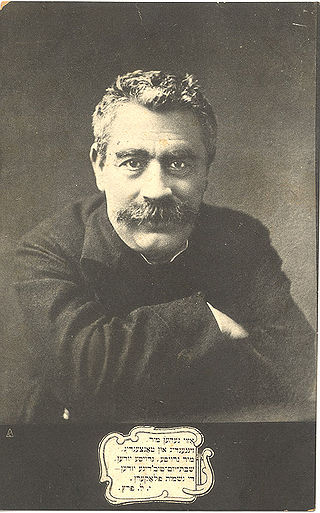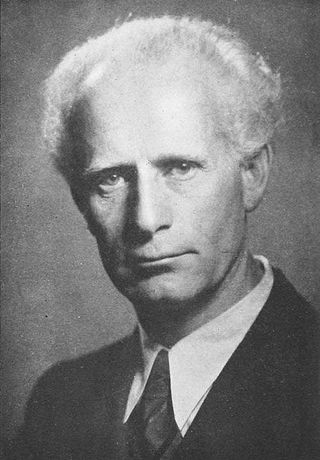
Di Yunge was the first major literary movement of Yiddish poetry in America. During the early 20th century, their work emphasized romanticism, individualism, subjectivism, and free and indirect expression.

Di Yunge was the first major literary movement of Yiddish poetry in America. During the early 20th century, their work emphasized romanticism, individualism, subjectivism, and free and indirect expression.
Yiddish literature was most prominent in Eastern Europe during the century preceding World War I. In the period leading up to World War II, Yiddish literature in Poland and Russia changed in response to the political status of Jews. For a time in-between, countries across the Americas developed a literature of new immigrants, [1] of which Di Yunge was the first important group of Yiddish poets in America. [2]
The writers of the literary movement known as Di Yunge emigrated to the United States from Eastern Europe between 1902 and 1911 as part of a wider migration of Jews from that region. Di Yunge, which translates as "the young ones" or "youngsters", typified the Jewish immigrant: young, unwed, and impoverished. [3] As a group, their influences included Heinrich Heine, German Expressionism, and Russian symbolism. Their work was characterized by its romanticism and advocacy for individualism, subjectivism, and free and indirect expression. [4] Di Yunge was the first school of Yiddish literature to stress an aesthetic standard above a social and national purpose; it sought to eschew the communal and didactic perspectives of the socialist labor poetry of the previous generation (represented by poets such as David Edelstadt and Morris Rosenfeld). [5] [6]
Di Yunge writers included I. J. Schwartz, Mani Leib, Zishe Landau, Itzik Manger, Aaron Zeitlin, Moyshe-Leyb Halpern and David Ignatoff. The group of poets differed in regional origin and politics. [1] Schwartz's Kentucky was the first American Yiddish epic—it tells how the new rural life of Jewish immigrants changed their Jewish spiritual life. Schwartz later won the 1970 Itzik Manger Prize for poetry in Israel. [1]
After World War I and the Russian Revolution of 1905, a less defiant group known as the Insichists (or "In-Zikh" [7] ), who sought to "refract the outer world through the prism of the self", replaced Di Yunge. [4]

Isaac Leib Peretz, also sometimes written Yitskhok Leybush Peretz was a Polish Jewish writer and playwright writing in Yiddish. Payson R. Stevens, Charles M. Levine, and Sol Steinmetz count him with Mendele Mokher Seforim and Sholem Aleichem as one of the three great classical Yiddish writers. Sol Liptzin wrote: "Yitzkhok Leibush Peretz was the great awakener of Yiddish-speaking Jewry and Sholom Aleichem its comforter.... Peretz aroused in his readers the will for self-emancipation, the will for resistance against the many humiliations to which they were being subjected."

Abraham Sutzkever was an acclaimed Yiddish poet. The New York Times wrote that Sutzkever was "the greatest poet of the Holocaust."

H. Leivick was a Yiddish language writer, known for his 1921 "dramatic poem in eight scenes" The Golem. He also wrote many highly political, realistic plays, including "Shop." He adopted the pen name of Leivick to avoid being confused with Moyshe-Leyb Halpern, another prominent Yiddish poet.

Yiddish literature encompasses all those belles-lettres written in Yiddish, the language of Ashkenazic Jewry which is related to Middle High German. The history of Yiddish, with its roots in central Europe and locus for centuries in Eastern Europe, is evident in its literature.

Moyshe-Leyb Halpern was a Yiddish-language modernist poet. He was born and raised in a traditional Jewish household in Zlotshev, Galicia and brought to Vienna at the age of 12 in 1898 to study commercial art. He then began writing modernist poetry in German. Upon returning to his hometown in 1907, he switched to writing in Yiddish. One of his best-known poems is a satire about his hometown.

David G. Roskies is an internationally recognized Canadian literary scholar, cultural historian and author in the field of Yiddish literature and the culture of Eastern European Jewry. He is the Sol and Evelyn Henkind Chair in Yiddish Literature and Culture and Professor of Jewish Literature at the Jewish Theological Seminary of America.

Celia Dropkin was a Russian-born American Yiddish poet, writer, and artist.
Dovid Hofshteyn, also known as David Hofstein, was a Yiddish poet. He was one of the 13 Jewish intellectuals executed on the Night of the Murdered Poets.

Der Groyser Kundes was a New York City, Yiddish language satirical weekly which ran from 1909 until 1927. It was entitled Der Kibitser for its first year of production.

Jonas Turkow was an actor, stage manager, director and writer. He received the Itzik Manger Prize for his contributions to Yiddish letters.

Mani Leib was a Yiddish-language poet.

Alter Esselin was a Jewish-American poet who wrote in the Yiddish language. He was born in Chernihiv, in the Chernigov Governorate of the Russian Empire on April 23, 1889, and died in Milwaukee, Wisconsin, on November 22, 1974. In fifty years of his life, he wrote and had published several hundred poems in such publications as Di goldene keyt, Di veg, Kundus, The Zukunft or Di Tsukunft(The Future) and many others.

Kadia Molodowsky was an American poet and writer in the Yiddish language, and a teacher of Yiddish and Hebrew. She published six collections of poetry during her lifetime, and was a widely recognized figure in Yiddish poetry during the twentieth century.

Fradl Shtok was a Jewish-American Yiddish-language poet and writer, who immigrated to the United States from Galicia, Austria-Hungary, at the age of 18 or 19. She is known as one of the first Yiddish poets to use the sonnet form; and her stories, which were less well received than her poems in her lifetime, have since been recognized as innovative for their exploration of subjectivity, and, in particular, for their depiction of Jewish female characters at odds with traditional roles and expectations.
Rikuda Potash was a Polish-born Israeli Yiddish language poet and short story writer. Sholem Asch called her "the Poetess of Jerusalem".
The Itzik Manger Prize for outstanding contributions to Yiddish literature was established in 1968, shortly before Itzik Manger's death in 1969. Manger "was and remains one of the best-known twentieth-century Yiddish poets." The Prize has been described as the "most prestigious in Yiddish letters". Apparently no Manger Prizes have been awarded after 1999.
Eliezer Greenberg was a Bessarabian-born Jewish-American Yiddish poet and literary critic.
Kathryn Ann Hellerstein is an American academic and scholar of Yiddish-language poetry, translation, and Jewish American literature. Specializing in Yiddish, she is currently a professor of Germanic Languages and Literatures and the Ruth Meltzer Director of the Jewish Studies Program at the University of Pennsylvania. She is known for her research focus on Yiddish women writers, notably Kadya Molodowsky, Malka Heifetz Tussman, and Celia Dropkin.